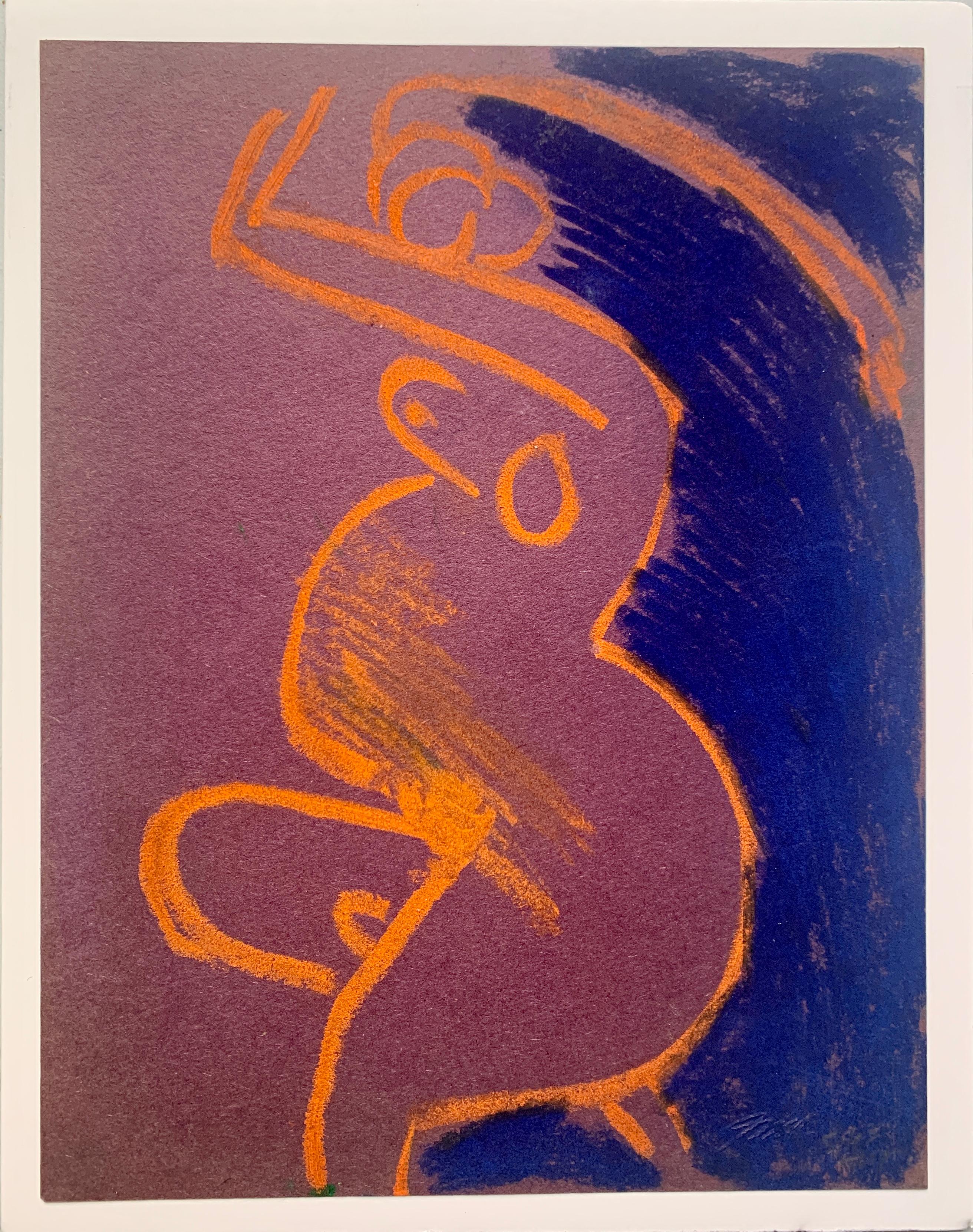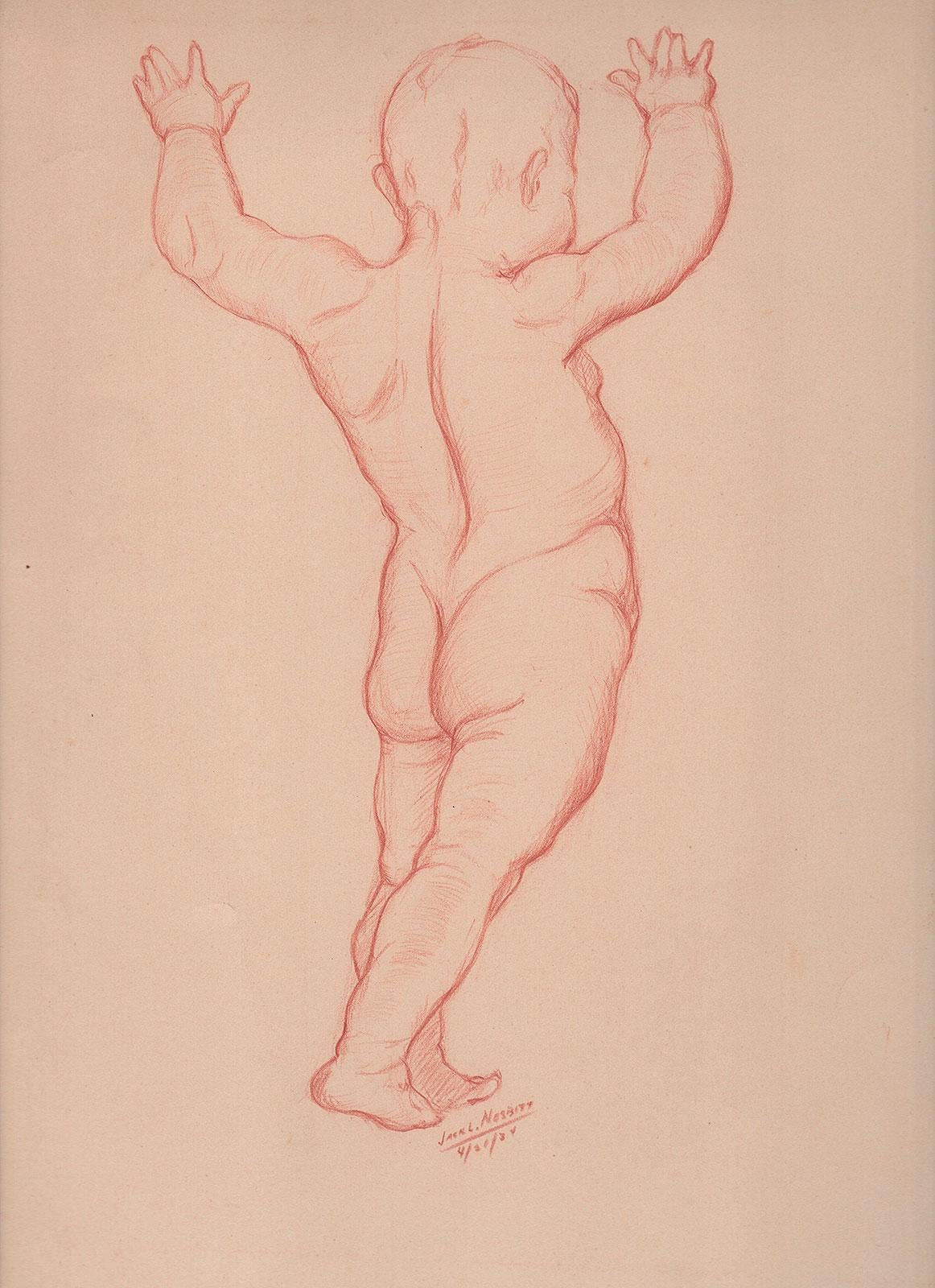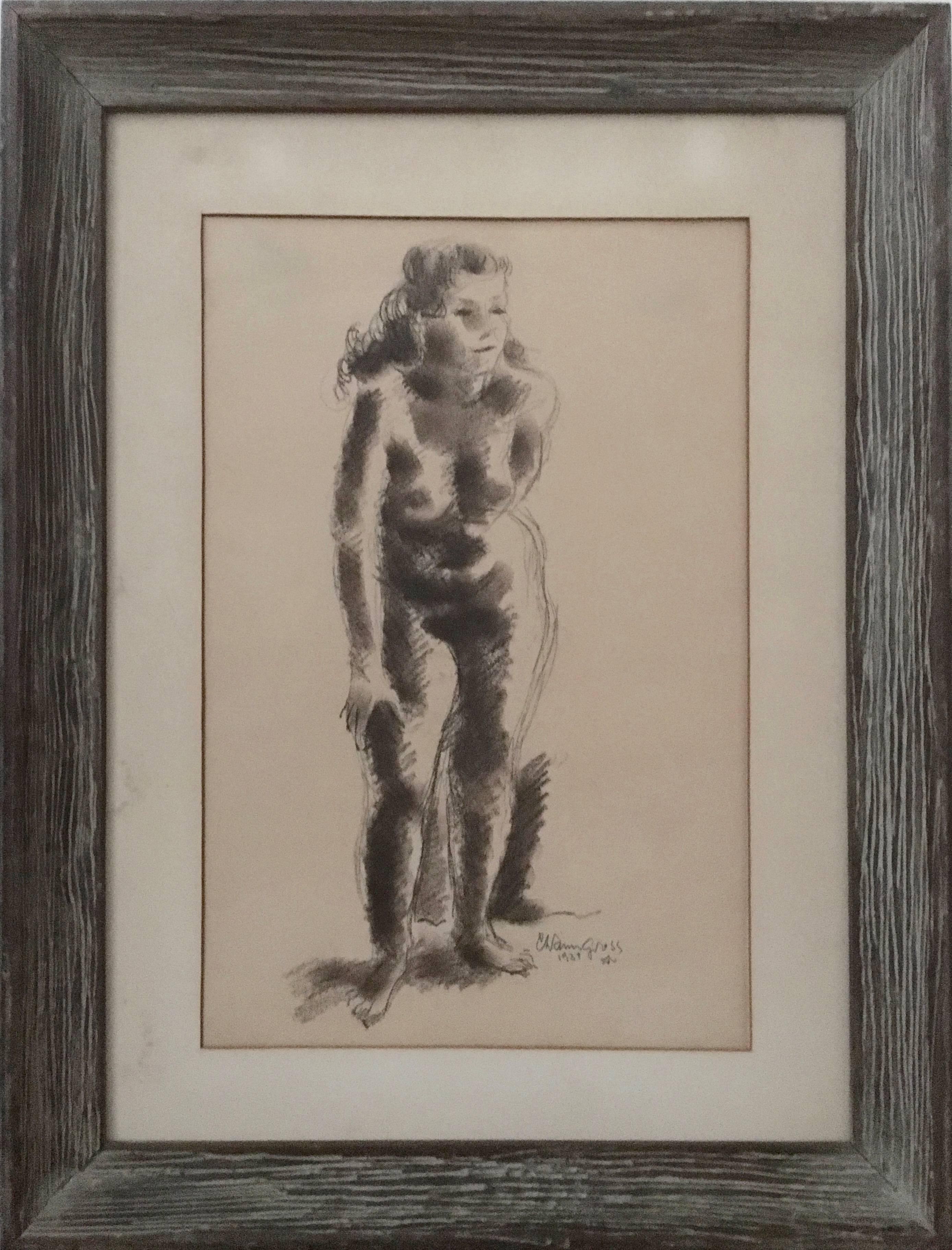Items Similar to Reclining Female Nude
Want more images or videos?
Request additional images or videos from the seller
1 of 9
Henry George KellerReclining Female Nudec. 1948
c. 1948
About the Item
Reclining Female Nude
Charcoal and colored chalks with white highlights on tan laid paper, c. 1948
Signed and monogrammed by the artist lower right
(see photo)
A masterpiece drawing demonstrating the foreshortening of the model's legs.
From the Leona G. Prasse Collection, former Curator of Prints and Drawings at the Cleveland Museum of Art.
Condition: Excellent
Image size: 12 3/8 x 20 5/8 inches
Provenance: Leona E. Prasse (her collector's stamp n
reverse)
Lynn Prasse Bittel, her niece
THOMAS FRENCH FINE ART, LLC
Henry Keller
(1869-1949)
Born aboard ship off Nova Scotia of German parents on April 3, 1869. The Keller family settled in Ohio. Henry studied in Cleveland at the Institute of Art and for 43 years taught at that school. During the 1890s he worked there at the Morgan Lithograph Company, during which time he studied in NYC at the ASL. Keller made his first trip to California in 1915 to attend the PPIE. Following a visit to San Diego in 1925, he spent several summers there. He was elected an associate of the National Academy in 1939. In 1948 he moved to San Diego to live with his son and died there on Aug. 3, 1949. The subjects of his watercolors, oils, lithographs, and etchings include horses, figures, landscapes of Ohio, San Diego, and from his world travels. Exh: Royal Academy (Munich) 1902 (silver medal); Armory Show (NYC), 1913; Carnegie Inst., 1914-44; AIC, 1929 (prize); Calif. WC Society, 1940; Cleveland Museum, 1950 (memorial). In: Library of Congress; Whitney Museum (NYC); MM; Cleveland Museum; Boston Museum.
Courtesy: AskArt
Source:
Edan Hughes, "Artists in California, 1786-1940," American Art Annual 1903-33
American Magazine of Art, Sept. 1936
Who's Who in American Art 1936-47
KELLER, HENRY GEORGE (3 Apr. 1869-3 Aug. 1949), painter and teacher, was born at sea as his parents, Jacob and Barbara (Karcher) Keller, came to Cleveland. In 1887, Keller entered the Cleveland School of Art, studying for 3 years, then studying at Karlsruhe in Germany 2 years before returning to complete his Cleveland education. He studied in Dusseldorf, then at Munich from 1899-1902, and also attended the Art Students' League in New York and Cincinnati School of Art, working as a lithographer to finance his schooling. He joined the teaching staff at Cleveland School of Art (see CLEVELAND INSTITUTE OF ART), serving until 1945.
Keller had little sympathy with modernism, seeing his function as expressing nature as he saw it. In 1928, Keller won the Davis Purchase Prize at Witte Memorial Museum in San Antonio; in 1929, the Blair Purchase Prize at the Art Institute Internatl. Exhibition of Water Colors in Chicago. He made 11 Carnegie shows in Pittsburgh and had 1-man shows throughout the country. In 1919, he won the Special Award for sustained excellence for entries in the first MAY SHOW at the CLEVELAND MUSEUM OF ART. Keller's themes were American, and he felt the Midwest was the great reservoir of the American Idea. He started a summer school at Berlin Hts., Ohio, ca. 1908. Keller married Imogene Leslie on 2 Jan. 1893 and had 2 sons, Henry Leslie and Albert Fay. Following his wife's death in 1948, Keller moved to San Diego, Calif. Both Keller and his wife are buried in the old burying ground at Berlin Hts. Village.
Courtesy Case
THOMAS FRENCH FINE ART, LLC
Henry Keller
(1869-1949)
A native of Cleveland, Ohio, Henry Keller had a forty-year career as a teacher at the Cleveland School of Art and also directed a summer school at Berlin Heights, Ohio. He became the first artist in Ohio to achieve distinction in watercolor. By combining watercolor with tempera and other media, he created innovations widely adopted by his students including Charles Burchfield, Paul Travis, and Frank Wilcox. However, few remaining examples of his work have been found.
He was first trained at the Western Reserve School of Design for Women where he received special permission to attend classes. In 1890, he spent a year in Karlsruhe, Germany at the Art Academy and then returned to Cleveland to work as a circus poster designer for the Morgan Lithograph Company.
In 1899, he returned to Germany for further art studies and enrolled at academies in Dusseldorf and Munich. In 1902, he received a medal in a Munich Royal Academy exhibition and then returned to Cleveland to begin his teaching career.
Around 1903, he began painting outdoors at his family's farm near Berlin Heights, about 40 miles west of Cleveland, and since it was easily reached by train, other artists began to follow. By 1909, he had formally established his art school there.
He also collaborated with John MacCleod of Western Reserve University on a three-year scientific study of color theory. And 1913 he co-authored an article on "the physiology of color vision in modern art."
By 1913, he was the region's most outspoken advocate of avant-garde art and wrote the introductory essay for the catalogue of an exhibition of French Cubist paintings at the William Taylor Gallery in Cleveland in the summer of 1913. He lectured widely on the defense of European modernism, and two of his paintings were in the New York Armory Show.
Keller constantly traveled and often used watercolor to capture his impressions of Spain, Portugal, Puerto Rico, and the Austrian Tyrol. To capture the essence of each place he often worked quickly with spontaneous brushstrokes and pure color rather than the "literal descriptions of topography."
He was especially influenced by Paul Cezanne and Henri Matisse and developed a method of outlining his forms with intense blue to create a sense of volume. He also adopted Japanese methods of using decorative, rhythmic designs and the spirited brushwork in Chinese watercolor painting.
Courtesy: AskArt
Credits:
Robinson, W. "Henry Keller, Paintings of a Traveler." American Art Review, Winter 1994
- Creator:Henry George Keller (1870-1949, American)
- Creation Year:c. 1948
- Dimensions:Height: 12.38 in (31.45 cm)Width: 20.63 in (52.41 cm)
- Medium:
- Movement & Style:
- Period:
- Condition:
- Gallery Location:Fairlawn, OH
- Reference Number:
About the Seller
5.0
Recognized Seller
These prestigious sellers are industry leaders and represent the highest echelon for item quality and design.
Platinum Seller
These expertly vetted sellers are 1stDibs' most experienced sellers and are rated highest by our customers.
Established in 1978
1stDibs seller since 2013
712 sales on 1stDibs
Typical response time: 1 hour
Associations
International Fine Print Dealers Association
- ShippingRetrieving quote...Ships From: Akron, OH
- Return PolicyA return for this item may be initiated within 10 days of delivery.
More From This SellerView All
- Standing Female NudeBy William SommerLocated in Fairlawn, OHStanding Female Nude Match stick and ink drawing, c. 1925 Signed with the estate stamp B Sheet size: 21 x 16 inches Created at the Kakoon Arts Klu...Category
1920s American Modern Nude Drawings and Watercolors
MaterialsInk
- Seated NudeBy August F. BiehleLocated in Fairlawn, OHSeated Nude Match Stick ink drawing, c. 1925 Signed by the artist in pencil lower right: A. Biehle Created at the Kakoon Arts Club, Cleveland. Influenced by friend and fellow artist...Category
1920s American Modern Nude Drawings and Watercolors
MaterialsInk
- Three GracesBy Ray H. FrenchLocated in Fairlawn, OHThree Graces Pentel marker on paper, 1965 Signed and dated by the artist lower left (see photo) Part of a series of 100 drawings, this number 97 (annotated lower right corner) Condition: Excellent Sheet/Image size: 20 x 15 inches Provenance: Estate of the Artist Martha A. French Trust Ray H. French: The Evolution of an Artistic Innovator Printmaker, painter, and sculptor Ray H. French was born in Terre Haute, Indiana on May 16, 1919. Terre Haute was a cultural wasteland before the opening of the Sheldon Swope Art Museum in 1942. Thus, with a father as a coal miner and carpenter, art remained a luxury for Ray. Nevertheless, local art teachers Mabel Mikel Williams and Nola E. Williams helped to foster his creativity and unshakable drive to create things of beauty. After high school, Ray attended the John Herron School of Art in Indianapolis. His studies there were interrupted by the outbreak of World War II, during which he developed surveillance photographs for the Army Air Force. After the war, Ray transferred to the University of Iowa on the G.I. Bill, where he received both his BFA and MFA degrees. The University of Iowa during the 1940s was a cultural mecca with many major art historians and artists. While in Iowa, Ray played an important role in this culture by becoming a founding member of the Iowa Print...Category
1960s American Modern Nude Drawings and Watercolors
MaterialsPermanent Marker
- Untitled (seated female nude)By Henry KellerLocated in Fairlawn, OHSeated Femake Nude Graphite and chalk on tan paper, c. 1920 Signed "Keller" and signed again with the artist's initials in a cypher A finished life drawing most probably exhibited at...Category
1920s American Modern Nude Drawings and Watercolors
MaterialsGraphite
- Three Nudes in a GardenBy Aaron BohrodLocated in Fairlawn, OHThree Nudes in a Garden Graphite, c. 1928-1933 Initialed in pencil lower left (see photo) Illustrated: Elliott & Wooden, Aaron Bohrod: Figure Sketches, Fige 9, page 32 (see photo) A...Category
1920s American Modern Nude Drawings and Watercolors
MaterialsGraphite
- Divertimento I (Picasso)By Conger A. MetcalfLocated in Fairlawn, OHDivertimento I (Picasso) Graphite, color wash and oil paint on coated glossy paper, c. 1940 Signed C. Metcalf lower left (see photo) Inscribed Matisse, Picasso, C. Metcalf lower left by the artist (see photo) Condition: Irregular sheet margins Framed in a carved corner, gilt decorated frame with foliate corners. Very complimentary to the work!!! ( See photo) Oil paint transfer on verso Three small bits of masking tape along the upper margin from previous framing Colors fresh, appears to be no fading Photos available upon request Sheet/Image size: 13 x 9 1/4 inches Provenance: Private Collection, Ohio Exhibited: Childs Gallery, Boston, 2013-2023 (see label) Conger Metcalf (1914–1998) was an American painter. "He was born in Cedar Rapids, Iowa and died in Boston, Massachusetts. Metcalf began his art studies in 1932 at the Iowa Stone City Art Colony, headed by American Regionalist painter Grant Wood. Metcalf continued his studies at Coe College in Cedar Rapids with Stone City co-founder Marvin Cone...Category
1940s American Modern Nude Drawings and Watercolors
MaterialsOil
You May Also Like
- Male TorsoBy John KochLocated in London, GBPencil, coloured pencil and chalk on paper, titled (lower left), signed (lower right), 31cm x 46cm, (51cm x 68cm framed). John Koch was an American painter and teacher, and an impo...Category
1950s American Modern Nude Drawings and Watercolors
MaterialsPaper, Chalk, Pencil, Color Pencil
- Statue of Young Boy in Fountain on the PlazaBy Jackson Lee NesbittLocated in New Orleans, LAThis very early original red conte drawing is signed "Jack L. Nesbitt, 4/21/34". On the back of the drawing, Nesbitt has written "Quick sketch from fountain on Plaza". Jack was a student of Thomas Hart Benton at the Kansas City Art Institute during this period. The figure on the drawing is of a nude young boy with both arms in the air. A very rare early work by this fine artist. Jackson Lee Nesbitt, a noted printmaker and painter of the American Scene, dedicated his artistic career to the portrayal of ordinary people going about the business of their lives. A native of Oklahoma, Nesbitt created scenes from the Midwest during the 1930s and 1940s, but in the 1950s, when interest in his work diminished, he moved to Atlanta and established a second career in advertising. Thirty years later, Nesbitt sold his business and resumed his artistic career from Atlanta. He was born in McAlester, Oklahoma, on June 16, 1913, the only child of LuCena Grant and Howard Nesbitt. The family resided in Muskogee, Oklahoma, where his father owned a commercial printing business. Jack, as Nesbitt was known, helped out in the family business until 1931, when he enrolled at the University of Oklahoma in Norman. Two years later Nesbitt enrolled at the Kansas City Art Institute in Missouri. As a first-year student, he learned etching from John deMartelly, attended Ross Braught's painting class, and met his future wife, Elaine Thompson, who was a costume design student. Thomas Hart Benton, who joined the faculty in the fall of 1935, quickly became a close friend and mentor to the younger artist. In 1937 the management of the Sheffield Steel Corporation contacted deMartelly concerning an etching commission. Because Nesbitt was an outstanding student, his teacher suggested him for the job. When Nesbitt arrived at the plant one afternoon, he was taken to the open-hearth furnace area, where he diligently sketched anonymous workers in that dramatic setting until five o'clock the following morning. On the strength of his sketches, he was commissioned to create a series of etchings illustrating different phases of the steel industry. The commission launched Nesbitt's career as a professional artist. The commission with Sheffield Steel Corporation provided the financial security that enabled Jack and Elaine Nesbitt to marry on June 1, 1938. He graduated from the Kansas City Art Institute about the same time. Working as a freelance artist, Nesbitt augmented his commissioned work with genre scenes of the Midwest, and he routinely went with Benton on sketching trips to rural Arkansas. Beginning in 1939 Nesbitt's work gained widespread recognition. Open Hearth Door, a Sheffield Steel Corporation painting, was chosen to represent Missouri in the American Art Today exhibition at the New York World's Fair. Associated American Artists selected one of his etchings, Watering Place, for an edition of 250 prints that were sold through subscription. Having a print published by the association ensured national distribution, and four more of Nesbitt's works, all of rural southern genre scenes, were later selected by the print publisher. Over the next decade Nesbitt's work was exhibited in California, Colorado, Illinois, Missouri, New York, and Oklahoma. He was awarded the Eames Prize by the Society of American Etchers in 1946, and his work was included in the book American Prize Prints of the Twentieth Century, by Albert Reese. Major corporations with operations in the Midwest, including Brown and Bigelow, Butler Manufacturing Company, Humble Oil and Refining Company, Omaha Steel Works, Pratt and Whitney...Category
1930s American Modern Figurative Drawings and Watercolors
MaterialsConté
- "Pregnant Lady" American Modernist Original DrawingBy Jack HooperLocated in Arp, TXJack Hooper "Pregnant Lady" c. 1960s Conte crayon on purple paper 8.5"x11" unframed Signed and dated in pencil lower right *Custom framing available for a...Category
Mid-20th Century American Modern Figurative Drawings and Watercolors
MaterialsConté, Paper
- Ink Drawing Man in Suit and Hat with NudeBy Jonathan ShahnLocated in Surfside, FLProvenance: Hinckley & Brohel Gallery Jonathan Shahn, Born 1938 has been making sculpture, drawings and prints of the human figure since the early 1960s. He teaches at the Art Studen...Category
20th Century American Modern Figurative Drawings and Watercolors
MaterialsPaper, Ink
- Rare Early Nude Drawing American Modernist SculptorBy Chaim GrossLocated in Surfside, FLThis is a wonderful drawing by one of America's most treasured artists, Chaim Gross. Throughout his lifetime Gross has gone through tragedy and a real test of faith however, he has the unique ability to focus and direct his expression to the most joyful and beautiful works of art, such as the present lot. For more than sixty years Chaim Gross's art has expressed optimistic, affirming themes. His acrobats, cyclists, and mothers and children convey joyfulness, exuberance, love, and intimacy. This aspect of his work remained consistent with his Hasidic heritage, which teaches that "only in his childlike happiness is man nearest to God." Chaim Gross, born in Wolowa, Austria in 1904, was educated at the Beaux Arts Institute of Design and at the Art Student's League in New York. Chaim Gross's work was greatly influenced by his experiences during a period of international conflict, World War II. He had moved to Kolomyya from Wolowa to get a better education, but the Germans came to occupy, killing, raping, and looting. Gross and his family were chased from one village to the next. He wrote, "We were sleeping on roofs and in the fields, with the sound of cannon fire...Category
20th Century American Modern Nude Drawings and Watercolors
MaterialsCharcoal, Pastel, Pencil
- Chicago Modernist Line Drawing Reclining Nude WPA Artist. Exhibited WorkBy William S. SchwartzLocated in Surfside, FLReclining Nude.Early modernist line drawing, by American artist William S. Schwartz, c. 1940, gouache painting, signed with initials, framed. (size includes frame). Work is reminisce...Category
Mid-20th Century American Modern Nude Drawings and Watercolors
MaterialsPaper, Charcoal
Recently Viewed
View AllMore Ways To Browse
Extra Large Stone Planters
Anne Sophie Ogaard
Daisy Dodd
Iris Marie
Oil Painting By Novak
Sharing Chores
Uliviero Ulivieri
Davenport Ford
Gianna Tesone
Mexican Cemetery Artwork
Albert Watson Christy
Anima Mundi
David Hockney Rakes Progress
Erte Winter
Extra Large Swedish Painting
Jeremiah Chagall
Jonathan Stuart
Jukebox Speaker





